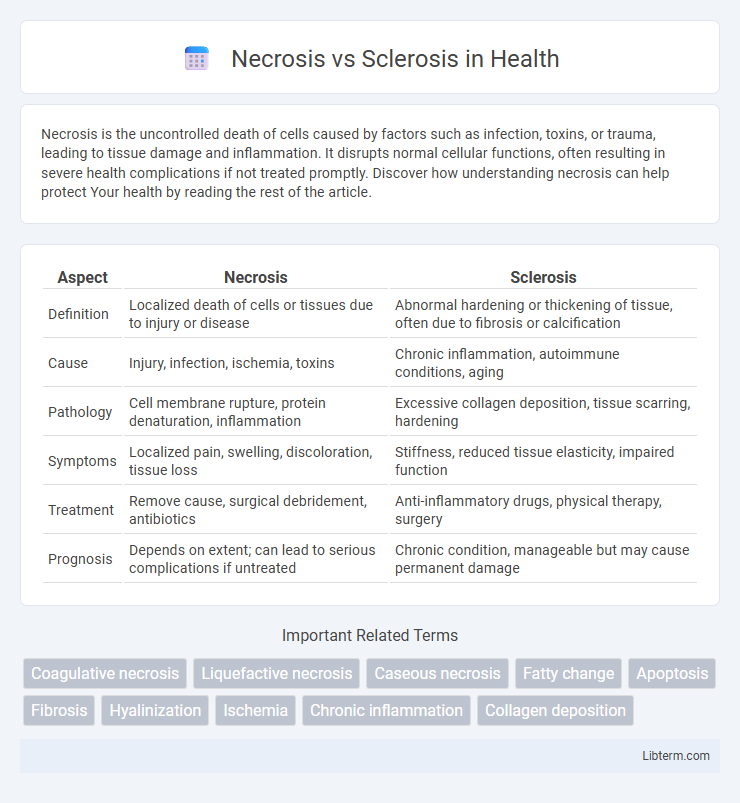Necrosis is the uncontrolled death of cells caused by factors such as infection, toxins, or trauma, leading to tissue damage and inflammation. It disrupts normal cellular functions, often resulting in severe health complications if not treated promptly. Discover how understanding necrosis can help protect Your health by reading the rest of the article.
Table of Comparison
| Aspect | Necrosis | Sclerosis |
|---|---|---|
| Definition | Localized death of cells or tissues due to injury or disease | Abnormal hardening or thickening of tissue, often due to fibrosis or calcification |
| Cause | Injury, infection, ischemia, toxins | Chronic inflammation, autoimmune conditions, aging |
| Pathology | Cell membrane rupture, protein denaturation, inflammation | Excessive collagen deposition, tissue scarring, hardening |
| Symptoms | Localized pain, swelling, discoloration, tissue loss | Stiffness, reduced tissue elasticity, impaired function |
| Treatment | Remove cause, surgical debridement, antibiotics | Anti-inflammatory drugs, physical therapy, surgery |
| Prognosis | Depends on extent; can lead to serious complications if untreated | Chronic condition, manageable but may cause permanent damage |
Understanding Necrosis and Sclerosis: Key Definitions
Necrosis refers to the premature death of cells and tissues caused by factors such as injury, infection, or lack of blood supply, leading to irreversible damage and inflammation. Sclerosis is characterized by the hardening or stiffening of tissue due to excessive fibrosis or abnormal collagen deposition, often resulting from chronic inflammation or autoimmune reactions. Understanding the pathological mechanisms of necrosis and sclerosis is essential for diagnosing and treating conditions like myocardial infarction, multiple sclerosis, and systemic sclerosis.
Causes of Necrosis vs Sclerosis
Necrosis results from cellular injury caused by factors such as ischemia, infections, toxins, or trauma leading to unregulated cell death and tissue breakdown. Sclerosis arises from chronic inflammation or prolonged tissue damage, triggering excessive collagen deposition and hardening of tissues. Understanding the distinct pathological mechanisms highlights ischemic or toxic injury as primary causes of necrosis, while persistent inflammation promotes sclerosis.
Cellular and Tissue Changes in Necrosis
Necrosis involves irreversible cellular damage characterized by loss of membrane integrity, swelling, and enzymatic digestion of cell components leading to tissue disintegration. Mitochondrial dysfunction and depletion of ATP result in disrupted ion gradients and cytoplasmic leakage. In contrast, sclerosis is defined by increased fibrosis and extracellular matrix deposition, leading to tissue hardening without immediate cellular death.
Cellular and Tissue Changes in Sclerosis
Sclerosis involves the abnormal hardening and thickening of tissue due to excessive collagen deposition by fibroblasts, leading to a dense, fibrotic extracellular matrix. Cellular changes in sclerosis include activation of fibroblasts and myofibroblasts, increased synthesis of collagen types I and III, and infiltration of inflammatory cells releasing profibrotic cytokines such as TGF-b. Unlike necrosis, which is characterized by cell death and tissue degradation, sclerosis reflects a chronic repair response resulting in structural tissue remodeling and loss of normal function.
Pathophysiology: Comparing Necrosis and Sclerosis
Necrosis involves uncontrolled cell death due to injury, infection, or ischemia, characterized by cell membrane rupture and inflammation. Sclerosis, in contrast, is the pathological hardening or thickening of tissue from excessive collagen deposition and fibrosis, often resulting from chronic inflammation or autoimmune processes. While necrosis signifies tissue destruction, sclerosis reflects a reparative response leading to tissue stiffening and loss of function.
Clinical Manifestations and Symptoms
Necrosis presents clinically with localized pain, swelling, discoloration, and potential loss of function due to tissue death, often accompanied by signs of infection or systemic inflammatory response. Sclerosis manifests as hardening and thickening of tissues, leading to stiffness, decreased elasticity, and impaired organ function, with symptoms varying according to the affected system such as skin tightness in systemic sclerosis or vascular obstruction in atherosclerosis. Both conditions may cause chronic pain and functional limitations but differ fundamentally in their pathological processes and clinical sequelae.
Diagnostic Approaches: Necrosis vs Sclerosis
Diagnostic approaches for necrosis primarily involve imaging modalities such as MRI and CT scans, which reveal tissue death and loss of cellular integrity, alongside histopathological examination showing cell lysis and inflammatory infiltrate. In contrast, sclerosis diagnosis relies on identifying tissue hardening through imaging techniques like ultrasound and MRI that detect fibrotic tissue changes, combined with biopsy demonstrating increased collagen deposition and fibroblast proliferation. Biomarker analysis and clinical correlation further refine differentiation, with necrosis linked to acute cellular injury and sclerosis associated with chronic fibrotic remodeling.
Treatment Strategies for Necrosis
Treatment strategies for necrosis prioritize removing dead tissue through surgical debridement to prevent infection and promote healing. Adjunct therapies include antibiotics to address or prevent secondary infections and hyperbaric oxygen therapy to enhance oxygen supply and support tissue regeneration. Early intervention is crucial to limit the spread of necrotic tissue and improve patient outcomes.
Treatment Strategies for Sclerosis
Treatment strategies for sclerosis primarily focus on managing symptoms and slowing disease progression through medications such as corticosteroids, immunosuppressants, and biologics like monoclonal antibodies. Physical therapy plays a crucial role in maintaining mobility and muscle strength, while lifestyle modifications, including diet and stress management, support overall patient health. Early diagnosis and personalized treatment plans significantly improve patient outcomes in sclerosis management.
Prognosis and Long-Term Outcomes
Necrosis often leads to irreversible tissue damage and poor prognosis due to loss of cellular viability, increasing the risk of infection and organ dysfunction. Sclerosis, characterized by abnormal hardening and fibrosis, typically results in progressive tissue stiffening that can impair function but may stabilize over time with appropriate treatment. Long-term outcomes in necrosis depend on the extent of tissue loss, while sclerosis outcomes vary based on the underlying cause and degree of fibrosis progression.
Necrosis Infographic

 libterm.com
libterm.com